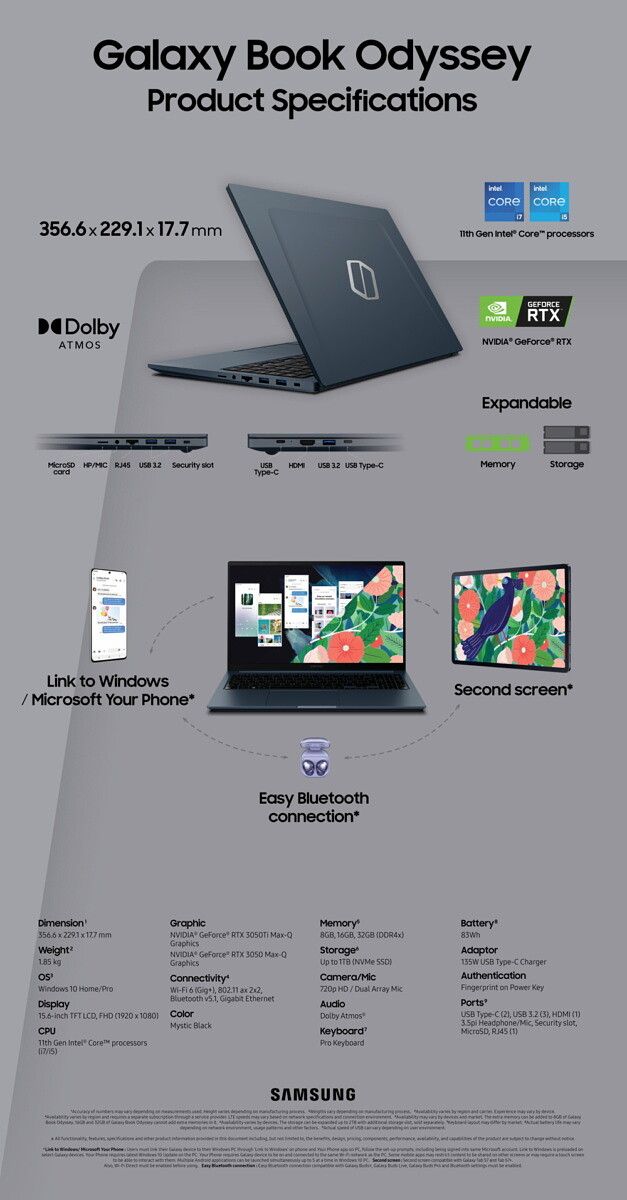Today, Samsung unveiled a series of new laptops, including the Samsung Galaxy Book Pro series. Coming in 13.3-inch and 15.6-inch configurations and sporting Intel 11th gen Tiger Lake UP3 CPUs and Intel Iris Xe graphics, they're as good as they get for thin and light laptops. Let's rewind into the graphics for a moment, though. While Intel's Xe graphics look promising and Intel has more ambitious plans than just providing decent graphics on thin and light laptops, you might want a proper gaming product if you're looking into more than just playing a couple of games, as this particular lineup only goes up to an NVIDIA GeForce MX450. Luckily, Samsung has just that as well: the Samsung Galaxy Book Odyssey, which was announced today right next to a regular, non-Pro, Galaxy Book sporting the yet-unseen RTX 3050 and RTX 3050 Ti graphics cards.
Yes, you didn't read that wrong: for graphics, you can choose between the NVIDIA GeForce RTX 3050 and RTX 3050 Ti graphics cards in their "Max-Q" version. NVIDIA hasn't yet made an official announcement on either of these GPUs, as their lineup currently bottoms at the RTX 3060 for both laptop products and desktop cards, but we know a thing or two about these GPUs thanks to leaks.
If this information is to be believed, then, both the RTX 3050 and 3050 Ti in the Galaxy Book Odyssey would sport the Ampere GA107 GPU that is, so far, still unused in other graphics cards, and both SKUs would come with 4 GB of GDDR6 memory across a 128-bit interface. Most notably, though, these would be the first truly entry-level RTX cards. This means that users on the budget side of the aisle will also be able to enjoy all of the advantages that come with RTX cards, such as real-time ray tracing and support for DLSS. It should be noted that last gen's entry-level lineup from NVIDIA consisted of the GTX 1650 and GTX 1660 series which did not have either RT cores for ray tracing or Tensor cores for DLSS, while the RTX lineup only went down to the RTX 2060.
As for the rest of the specifications, Intel's 11th gen H-class Core i5 and Core i7 processors handle the CPU side of things, while the laptop will come in 8 GB, 16 GB, and 32 GB of LPDDR4X RAM configurations, and up to 1TB of NVMe storage. It also comes with a 1080p display, albeit, unlike the other Samsung laptops announced today, it's not OLED but rather LCD. So all in all, this laptop should be able to provide a very decent 1080p gaming experience. It also comes with a 720p webcam as well as a fingerprint reader, microSD card support, and for connectivity, we have two USB-C ports, three USB 3.2 ports, an HDMI port, and a network port.
The Galaxy Book Odyssey will go on sale in August and will start at $1,399 for the "mystic black" base model. The long wait is probably due to Samsung actually trying to ensure they can meet the overwhelming demand they'll evidently face once these laptops are on sale. We all know what's happening with GPU availability right now, and yes, that has extended to gaming laptops as well.
As for the elephant in the room---will NVIDIA release desktop versions of the RTX 3050 and 3050 Ti? Probably, but since we don't have official word from them on even the existence of these GPUs just yet, you'll likely have to wait a bit before more information arises. Good luck trying to buy one at MSRP when it's out, though, since GPU availability is expected to remain very tight through the rest of 2021.


